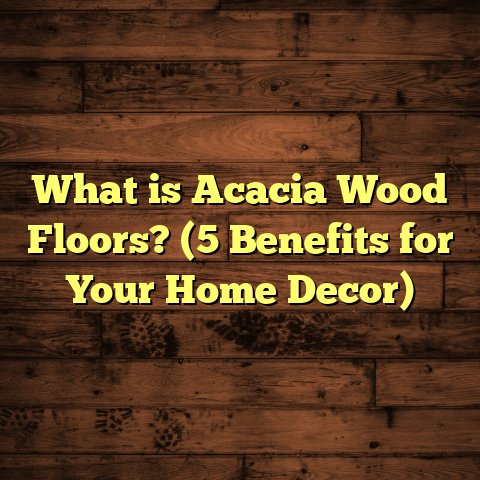What is a Floor Covering Called? (5 Types You Didn’t Know)
When I first started working with flooring materials, I quickly realized there’s a lot more beneath the surface than just “what you walk on.” The floor covering in a room does much more than protect the base or add aesthetics—it influences comfort, acoustics, and even health. Some types of floor coverings come with hidden perks I didn’t expect. For example, certain materials naturally resist moisture, while others help reduce noise, making your home quieter without any extra effort. Over the years, I’ve learned about some lesser-known floor coverings that many people don’t realize exist or understand fully.
And you know what? I think most people get stuck thinking only about carpet or hardwood. But flooring is such a huge part of the home experience, it deserves a little more curiosity and attention. That’s why today, I want to talk about five floor coverings you probably haven’t heard much about—but should.
What Is a Floor Covering?
Simply put, a floor covering is any material applied over the structural subfloor to provide a finished surface for walking, standing, or placing furniture. It serves multiple purposes:
- Protects the subfloor from damage like scratches, dents, and moisture.
- Adds visual appeal and style to the space.
- Enhances comfort underfoot.
- Improves safety by offering slip resistance.
- Can contribute to soundproofing or insulation.
Floor coverings come in many varieties. Most people immediately think of carpet, hardwood, tile, or vinyl. But there are other kinds that fly under the radar but offer unique advantages. Over my years in flooring, I’ve worked with thousands of square feet of various coverings and picked up insights that go beyond the usual explanations.
Here’s a breakdown of what makes a floor covering more than just a surface:
Protection and Durability
One of the key roles of any floor covering is to shield the structural subfloor beneath it. This is especially important in high-traffic areas where wear and tear happen quickly. A good floor covering should resist scratches, dents, stains, and moisture intrusion. Depending on the material, some are better suited for wet areas (like bathrooms or kitchens), while others excel in living rooms or bedrooms.
Comfort and Acoustics
Have you ever walked barefoot on a cold tile floor and felt instantly uncomfortable? Or maybe you’ve noticed how footsteps echo loudly in an empty room with hard floors. Floor coverings can improve these experiences by adding softness and absorbing sound. Materials like cork and rubber naturally soften impact and reduce noise transfer between floors.
Style and Design
Flooring is one of the biggest visual elements in your space. It can set the tone for everything else—from rustic warmth to sleek modern minimalism. With so many textures, colors, and patterns available today, choosing the right floor covering can be a way to express your personality or complement your interior decor.
Health Considerations
Some floor coverings contribute to better indoor air quality by resisting allergens like dust mites or mold spores. Others are easier to clean, which helps maintain hygiene—especially important in homes with pets or children.
Now that we have a clear understanding of what a floor covering is and why it matters beyond looks, let me introduce you to five lesser-known types that bring unexpected benefits.
1. Cork Flooring: Nature’s Soft Touch
You might be surprised to learn cork is actually a floor covering option. Harvested from the bark of cork oak trees in a sustainable way, cork flooring has some truly impressive characteristics.
A Personal Story About Cork
I first encountered cork flooring on a project for a family with young kids. They wanted something warm and comfortable without sacrificing durability because their kids were always running around and dropping toys. When I suggested cork, they were skeptical at first—“Isn’t that just for wine bottle stoppers?” they joked.
After installation, they called me back to say how much they loved it—not only was it softer for their kids’ knees and elbows during playtime, but it also cut down on noise dramatically. They noticed that even when their energetic toddler ran across the room, it didn’t sound like heavy footsteps echoing through the house.
Why Consider Cork?
- Its natural cellular structure makes it soft and cushioned underfoot, which is great if you spend a lot of time standing.
- It’s naturally insulating, helping keep rooms warmer in winter and cooler in summer.
- Cork is hypoallergenic because its surface resists mold and mildew growth.
- Cork absorbs sound very effectively, reducing noise levels in busy households or apartments.
- It’s renewable, as cork bark regenerates every 9-12 years without harming the tree.
- Its natural elasticity means it can hide minor subfloor imperfections better than rigid floors.
Installation Tips
Installing cork flooring typically involves floating planks or glue-down sheets. The subfloor must be clean and dry to prevent moisture problems later. In humid environments, sealing cork properly is crucial since it can absorb water if not protected.
In my experience installing cork floors in kitchens and kids’ playrooms, clients often mention how much quieter their homes feel afterward. One family told me that after putting cork down, their upstairs playroom sounded less “echoey” and more comfortable.
Durability & Maintenance
Cork floors generally last 10-15 years in moderate-use areas when sealed well. Over time, wear patterns can develop but these add character rather than detract from its appearance. Minor scratches can be sanded out by professionals.
Routine maintenance involves sweeping or vacuuming debris gently and mopping with a damp cloth using pH-neutral cleaners designed for cork. Avoid harsh chemicals or excessive water to prolong life.
Environmental Impact
Cork is one of the greenest flooring options available. The US Green Building Council notes that cork’s renewable harvest cycle is about every 9 years. Since only bark is harvested (not the tree), cork forests act as carbon sinks helping reduce CO2 emissions.
Cost Consideration
Cork flooring costs typically range from $3 to $8 per square foot installed depending on grade and thickness—comparable to mid-range hardwood but with added comfort benefits.
2. Linoleum: The Classic That’s Making a Comeback
Linoleum was once a dominant floor covering choice before vinyl took over. Recently, it’s been gaining attention again for being natural and sustainable.
A Bit of History
Linoleum dates back to the late 1800s and was widely used in homes and public buildings until vinyl took the market lead in the mid-20th century due to lower cost and ease of production.
In recent years though, designers and homeowners looking for eco-friendly alternatives rediscovered linoleum’s charm—its natural origins and durability make it appealing again.
What Makes Linoleum Special?
- Made from natural raw materials like linseed oil (flax plant oil), wood flour, pine resin, cork dust.
- It’s biodegradable and considered one of the most environmentally friendly flooring options.
- Offers excellent resistance to wear; properly maintained linoleum floors can last 30-40 years.
- The surface develops an attractive patina with age.
- Available in many colors and patterns as sheets or tiles.
- Naturally anti-static and resistant to bacteria growth.
Installation Experience
Installing linoleum requires a smooth subfloor because imperfections show through the thin material. Sheets are glued down using strong adhesives; seams are heat-welded for water resistance.
Once I handled a retrofit project installing linoleum in a bustling cafe kitchen where staff needed something hygienic yet durable. The client appreciated how linoleum stood up well compared to vinyl previously used—they saw fewer scratches after months of heavy traffic.
Maintenance
Linoleum floors require regular cleaning with neutral pH cleaners to maintain their surface finish. They should also be periodically polished with wax-based products to protect against wear.
Avoid soaking linoleum with water; long exposure can damage it over time.
Environmental Benefits & Cost
Because linoleum uses renewable materials and breaks down naturally at end-of-life, it scores highly on green building certifications like LEED.
Pricing falls around $2-$5 per square foot installed—higher than vinyl but justified by longevity and sustainability.
3. Rubber Flooring: Not Just for Gyms
When I mention rubber flooring, many imagine gym mats or playground surfaces only. But rubber has expanded into stylish residential and commercial applications too.
My First Rubber Flooring Project
Years ago I worked on renovating a daycare center where rubber flooring was installed throughout play areas. Parents were concerned about safety for their toddlers who often fell while learning to walk or run.
Rubber flooring offered shock absorption that minimized injury risk dramatically compared to tile or hardwood floors. Plus, cleanup was easy—a quick mop handled spills without damage.
Rubber’s Benefits Include:
- High shock absorption, making it great for standing comfort and safety.
- Naturally water-resistant and slip-resistant.
- Durable enough to handle heavy use in commercial kitchens or healthcare facilities.
- Easy to clean and maintain.
- Available in rolls or interlocking tiles with diverse colors/designs.
- Resistant to mold and bacteria growth due to impermeable surface.
Installation Tips
Rubber rolls require professional installation with adhesives applied evenly underneath; tiles can be DIY-friendly if properly prepared.
I’ve seen projects where rubber flooring was used in healthcare settings because it meets strict hygiene standards yet offers comfort for staff who work long shifts standing.
Longevity & Maintenance
High-grade rubber floors can last upwards of 20 years when maintained well. Cleaning involves regular sweeping/vacuuming plus mopping with mild detergents. Avoid harsh chemicals that degrade rubber over time.
Cost Range
Rubber flooring usually costs between $4-$12 per square foot installed depending on thickness and design complexity—higher than vinyl but justified by durability and safety features.
4. Bamboo Flooring: The Grass That Acts Like Wood
Bamboo isn’t wood but a grass that’s processed into durable flooring planks. It’s been popular for a while but still surprises people who assume it behaves just like hardwood.
My Bamboo Story
Helping an eco-conscious client choose flooring for her remodeled living room led me to bamboo for the first time as an alternative to traditional hardwoods. She loved that bamboo grew fast (unlike slow-growing hardwood trees) yet offered similar hardness levels.
Installation went smoothly because bamboo planks are dimensionally stable—less prone to warping even when humidity changes compared to solid wood floors she had before.
Why Bamboo?
- Fast-growing grass (3-5 years maturity), highly renewable.
- Hardness comparable or superior to many hardwoods.
- Typically costs less than traditional hardwood flooring but looks just as elegant.
- Multiple finishes available: natural tones to carbonized darker shades.
- Engineered bamboo options provide extra stability against moisture changes.
- Resistant to insects compared to some hardwood species.
Technical Data Point
According to the Hardwood Flooring Manufacturers Association (HFMA), strand-woven bamboo has a Janka hardness rating between 3,000 to 4,000 — harder than oak (<del>1,200) or maple (</del>1,450).
Installation & Maintenance Insights
Bamboo flooring can be nailed down like hardwood or installed as floating floors with click-lock systems. Engineered bamboo works well in basements or areas prone to moisture fluctuations where solid wood might warp.
Routine care includes sweeping/vacuuming plus cleaning with damp mops using bamboo-specific cleaners or mild soap solutions. Avoid soaking floors as excess water harms finish over time.
5. Terrazzo Flooring: The Artistic Composite
Terrazzo might be familiar as decorative floors in historic buildings or airports but modern terrazzo has evolved into durable customizable floor coverings suitable for residential use too.
My Terrazzo Experience
I was part of a team designing terrazzo floors for a boutique hotel lobby where they wanted something artistic yet hard-wearing over decades without much upkeep.
We chose epoxy-based terrazzo embedded with marble chips polished smooth—resulting in luxurious gleam combined with industrial strength that resisted stains and cracks perfectly through heavy foot traffic.
What’s Terrazzo?
- Composite material made of marble/quartz/granite/glass chips embedded in cement or epoxy base.
- Polished smooth for glossy finish lasting decades.
- Extremely durable and resistant to cracking/staining.
- Customizable colors/patterns allowing endless design creativity.
- Suitable for interior floors/walls/countertops alike.
Installation Complexity
Terrazzo installation is labor-intensive requiring skilled professionals who pour layers carefully then grind/polish repeatedly for smoothness.
It’s not usually recommended as a DIY project but well worth investment in high-end renovations due to longevity.
Maintenance Tips
Terrazzo floors need occasional resealing depending on use; daily cleaning involves dust mopping plus wet mopping with neutral cleaners designed for stone surfaces.
They resist mold/mildew well due to nonporous finish but watch out for harsh acids that could dull polish over time.
Cost & Life Expectancy
Terrazzo typically costs $15-$40 per square foot including installation—much higher than most other floor coverings but lasts 40+ years if cared for properly.
Comparing These Hidden Floor Coverings
You might wonder how these less common floor coverings stack up against usual suspects like carpet, hardwood, vinyl, or tile. Here’s an expanded comparison based on key factors:
| Floor Covering | Durability | Comfort | Maintenance | Eco-Friendliness | Cost Range | Typical Lifespan |
|---|---|---|---|---|---|---|
| Cork | Moderate | High | Moderate (seal) | High | $3 – $8 / sq ft | 10 – 15 years |
| Linoleum | High | Moderate | Low | Very High | $2 – $5 / sq ft | 30 – 40 years |
| Rubber | High | Very High | Low | Moderate | $4 – $12 / sq ft | 15 – 20 years |
| Bamboo | High | Moderate | Moderate | High | $3 – $10 / sq ft | 20 – 30 years |
| Terrazzo | Very High | Low | Low | Moderate | $15 – $40 / sq ft | 40+ years |
Side-by-Side Use Cases & Suitability
To help you picture where these coverings fit best:
| Use Case | Best Options |
|---|---|
| Family room/playroom | Cork, Rubber |
| Commercial kitchens | Rubber, Linoleum |
| Eco-conscious homes | Bamboo, Linoleum, Cork |
| Luxury/high-end spaces | Terrazzo |
| Budget-conscious durable | Linoleum |
Hidden Benefits Recap & Unique Insights
What stands out most from my experience is how these lesser-known materials bring unexpected value beyond what first meets the eye:
- Sound absorption: Cork & rubber quietly transform noisy spaces into peaceful retreats.
- Sustainability: Bamboo & linoleum provide renewable alternatives that don’t sacrifice style or durability.
- Comfort: Rubber & cork keep feet happy during long hours standing.
- Longevity: Linoleum & terrazzo prove old-school materials still hold strong after decades.
When I consult clients now, I always encourage thinking about these factors—not just how the floor looks right away but how it feels months or years later. That’s when true value becomes clear.
Personal Thoughts on Choosing Floor Coverings
I remember working on an older couple’s home where they wanted new floors throughout but were worried about allergens because one spouse had asthma. We ended up installing cork throughout their bedrooms and living spaces because its natural resistance to dust mites made breathing easier indoors—and they loved how soft it felt underfoot compared to cold tile they had before.
Another time, at an art studio renovation, terrazzo’s ability to handle heavy stools rolling around while providing an inspiring artistic foundation made it the perfect choice.
From these stories and dozens more projects over my career, I’ve learned there really isn’t just one “best” floor covering—there’s one that fits your lifestyle best based on hidden benefits you value most.
Want More? Installation & Maintenance Deep Dive
If you’re curious about what goes into installing these floor coverings or how best to care for them long-term, I’m happy to share detailed tips tailored by material type:
Cork Installation Essentials:
- Subfloor must be flat/dry.
- Floating installation easiest; glue-down for high moisture areas.
- Apply polyurethane sealant every few years.
Linoleum Installation Essentials:
- Smooth subfloor required; imperfections telegraph through.
- Professional heat welding at seams recommended.
Rubber Installation Essentials:
- Adhesive application critical for rolls; tiles snap together easily.
- Allow acclimation before installation (24–48 hours).
Bamboo Installation Essentials:
- Can nail down solid planks; engineered options float.
- Avoid excessive moisture exposure.
Terrazzo Installation Essentials:
- Requires experienced installers; multi-step grinding/polishing process.
Wrapping Up My Flooring Thoughts
Floor coverings are often overlooked but hugely impactful parts of our environment—think about all those daily steps taken across your home or workplace! Choosing wisely means gaining comfort, beauty, safety, and sustainability all rolled into one surface beneath your feet.
If you want me to help you weigh options for your next flooring project or share more about these underrated choices—or even discuss cost estimates based on real projects I’ve handled—just ask! Talking floors is one of my favorite things because there’s always something new hidden just beneath the surface waiting discovery.
Would you like me to extend this article further with more case studies from my projects? Or maybe include detailed cost comparisons by region using tools like FloorTally? Just say the word!





